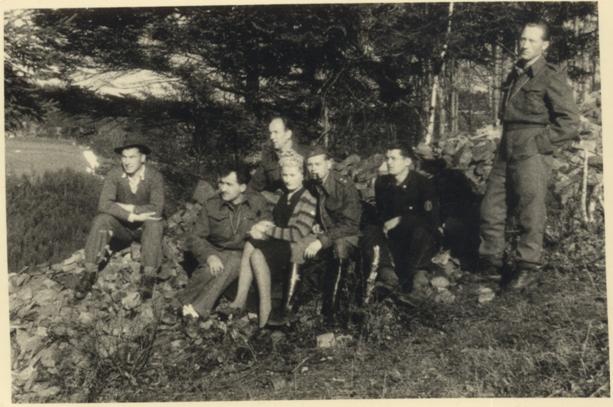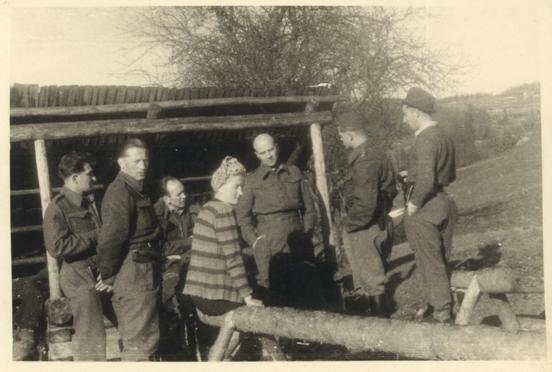
The Life and Times of Hubert Brooks M.C. C.D.
A Canadian Hero

 |
|
 |
The battles and our engagements were intensifying. It became apparent that we needed more and better armaments to fight the Germans. We now needed to attack German A.F.V.'s (armored fighting vehicle) and fortified bunkers. Continuing to steal armaments from the Germans simply could not provide us with the quantities of armaments and ammunition we needed in a timely manner nor the quality firepower that was needed. An additional weakness was that the partisans did may have had access to the lubricants necessary to maintain the cleanliness and operational integrity of their weapons.
In a typical active mobilized partisan unit of 100 men, each man would have a weapon of some sort, between about 80 men there would be on average 4 machine guns. In addition a partisan may have had a couple of grenades. Our weakness was both the quality of the weapon itself be it a hand gun or a family hunting rifle and sufficient ammunition for this weapon. A good percentage of our hand grenades were manufactured locally. A local explosive known as SHEDDITE with the addition of some plastic, locally supplied fuses and Allied supplied detonators resulted in quite an effective hand grenade. Some anti-personal bombs were also manufactured locally.
We clearly needed to upgrade our armament and ammunition situation for us to be even more effective in the war effort against the Germans.
The command in London had determined that the plan issue of armaments in a supply drop was to be one OW set per platoon. This OW set
contained 21 pistols, 18 Sten SMG, 2 Bren LMG, one 3 inch mortar and one W/T set as its basic constituents. Along with this however there was also
237 lbs plastic, 103 grenades_82, and 40 grenades_mills.
In addition ammunition and lubricants - essentially Vaseline to maintain the integrity of the firearms was sent.
Winter clothing and money to pay the partisan troops was also expected.
(Pay was based on 3 pay levels, First, Second and Third classes with pay levels as I recall of
2550 zł, 2125 zł and 1700 zł per month as well as 600 zł per month per dependant in the family.)
I was asked to help coordinate with the Allies in Italy an arms air drop in our area.
I was sent to work with a special Home Army troop of 1 PSP AK known as the "Pelikany" (English: "Pelicans") that operated an underground radio station. We wanted to use this radio station to coordinate with the Allies the first armament drop in the area in WWII. This first drop was originally to be at Dzielec mountain (near Mogielicy and Słopnice village). This would have taken a few days to set in place but we finally agreed on a drop zone on the slopes of Slopnice Mountain which was much easier for us.
The Pelicans activity to arrange/co-ordinate the drop of armaments and supplies from the Allies, principally flying out of Cerignola, Italy started late 1943.
One principal drop zone was "Sokół" (9km to the east of Ćwilina) with a backup located at "Ćwilina".
Other backup drop locations included:
"Sikora 1"(23km to the north-east of Nowy Targ)
"Sikora 2"(24km to the north-east of Nowy Targ)
"Sroka 2"(16km to the north-east of Nowy Targ)
Activities to co-ordinate for the drop included; a team of partisans responsible for activating the signaling lights to assist the Allied aircraft with drop navigation, a group of partisans to retrieve
the dropped "package" (the wind at times could blow several of the "packages" up to several kilometers from the nominal drop site - a real problem), ringing the drop zone were patrols of partisans to ensure
that no one unintentionally
entered the area during the drop operation. Obviously transport (usually horse drawn wagons) also had to be arranged to carry away the dropped armaments / supplies.
Later, most notably in November and December 1944, this Pelican group would coordinate further armament, supply and paratrooper drops from Allied airplanes in the Szczawa area most notably the "Wilga" drop location (located at the so-called Szczawa glades) .

|
|
|

|
|
|

|
|
|

|
In practice it was usually impossible to take prisoners and when we captured Volksdeutche traitors we liquidated them summarily without holding any sort of trial. Our company had been given carte blanche to deal with the Polish-German spies.
Such was the case of our surprise encounter the day we waited for our first parachute drop from Italy the end of May early June 1944. We had arrived at the drop zone early in the afternoon to ensure that everything was ready for the plane that night, when two hunters stumbled into our midst. It was good deer country there on the slopes of Slopnice Mountain and we were not surprised to find hunters.
We searched them and realized the name on one man's papers rang a bell right away. He was no less than the Vice President of the Polish Propaganda Department of the Generale Government! We could not have let them go anyhow as they had discovered our drop zone, but the fact that he was a notorious collaborator sealed the vice–president's fate.
John and I and one of the men took the pair into the woods and shot them immediately. When the Germans eventually heard of this they executed 30 Polish prisoners in Cracow and although I myself never saw any, I know that posters were put out with a price on the heads of the two British soldiers who had participated in the liquidation.
The plane from Italy came through on time that night and we excitedly gathered up seven long canisters of
Bren guns, hand grenades, plastic explosives, detonators, radio transmitter and medical supplies. Some of the parachuted boxes were buried
so deep in the ground that they had to be dug out.
This was the first drop that we had received in the area during our entire fight. The next minor supply drop would not occur until late 1944.
Editor's Note:

According to US Air Force Report 121 Special Operations: AAF Aid to European Resistance Movements, 1943-1945, by Harris G. Warren (1947) :
Supply to the Underground in Poland was carried out principally by the RAF and Polish aircraft, initially from the United Kingdom and North Africa, and later from Italy. Stores at the Brindisi warehouses, collectively known as "Paradise Camp", were packed under British supervision.
The Polish Special Duties Squadron 1568 under the command of Colonel Jazwinski had moved to Campo Casale, Brindisi (known as Base 11 or Operation Daybreak or Jutrzenka) to be as close as possible to Poland. The 1568 reported into the RAF 334 Special Duties Wing, which in turn was a part of the Balkan Air Force.
Deliveries from the Mediterranean theatre began on a very small scale in January 1944 by No 1586 Polish Flight, which had arrived at Blida in November 1943. The effort gradually increases with RAF aid. By May 1944 76 successful sorties out of 122 attempts had dropped 82.5 tons of supplies.
Between May and August 1944 two squadrons of the 205 Bomb Group (RAF) and 148 Squadron (RAF) supplemented the activity of the 1586 Polish Flight. These units succeeded in completing 84 of 170 attempted sorties and delivered 100 net British tons ( 2,200 lbs). Some 30 aircraft however were lost.
In September the entire 205 Group participated in supplying Warsaw, but the effort was small. Less than 23 tons were delivered by 19 successful sorties in 47 attemps. Of the 10 aircraft lost, 8 were from the 1586 Polish Flight.
The US Eigth Air Force made one mass drop to Warsaw. On September 18, 1944 three groups of 110 B-17's were dispatched, of which 107 dropped 1,284 containers, with the loss of
two planes. Although the Americans claimed that the drop was very successful, the Russians claimed that 50 percent of all supplies dropped fell into German hands.
US General Arnold did not favor a continuation of the Polish missions because they detracted from the offensive efforts and subjected the Allies to heavy losses.
Small delieries of supplies continued to reach the Polish Underground from Italy. The Polish Flight completed 3 sorties in 21 attempts in October, and the 34 Squadron (SAAF) lost two Liberators in completing one sortie in 6 attempts.
Only the 301 Polish Squadron (formerly 1586 Polish Flight) flew to Poland in November of 1944. In completing 4 of 15 sorties, the squadron dropped less than 6 net British tons.
After December 1944, when 9 of 25 sorties were completed, the allotment of supplies to Poland ended.
Difficulties encountered on route to the target which could scrub the mission included; bad weather, inability to locate the LZ (landing zone), navigation factors, enemy night fighters and/or anti-aircraft fire,
and delays occasioned by ground factors.
Bad weather was the most serious obstacle. Approximately 55% of the unsuccessful sorties from Italy during the period February 12, 1944 to December 1944 failed due to weather.
Precision co-ordination needed to exist between the aircraft and the partisan reception committee to realize a successful drop. The drop zone had to be ready, identification signals exchanged, and the aircraft dispatcher had to time the drop such that the containers could be recovered. In Poland, dropping zones were nearly always in rugged mountainous country where the danger was one of terrain and poor night time visibility. Pilots had to fly at about 600 feet over the drop zone which was often about three to five thousand feet below the surrounding peaks and ridges.
This supply drop of armaments generated a lot of excitement and anticipation of what we could now do. From approximately June 5th to 8th of 1944 soldiers from (Komenda) Obwód Limanowa AK together with partisans of unit "Wilk" (Wolf) under command of "Filip" (kpt, Julian Krzewicki, the commander of III Battalion 1 PSP AK) held exercises near the village of Kostrza (located near Limanowa) where we familiarized ourselves with the new arms and ammunition.
The following sequence of remarkable photos is taken from this exercise in a mountain clearing near the village of Kostrza.
|
|
|
|
|
|

|
|
|
|
|

|
|
|
The armaments received were not all distributed to the men. Most were stored in secret dumps under the control of our Area Commander (in this case "Filip") to be used for approved operations.
Our unit and those fighting near the Carpathian mountains were now well armed, being in possession of a considerable amount of captured arms and German stores and of British arms and equipment dropped into our area. As it would turn out in the winter battles to come, the one thing we were always short of was warm winter clothing.
These were used to good effect against German A.F.V.'s (armored fighting vehicle) and bunkers.
| PREVIOUS PAGE | GO TO TOP OF PAGE FOR INTER- and INTRA- CHAPTER NAVIGATION MENUS |
NEXT PAGE |
The Life and Times of Hubert Brooks M.C. C.D.